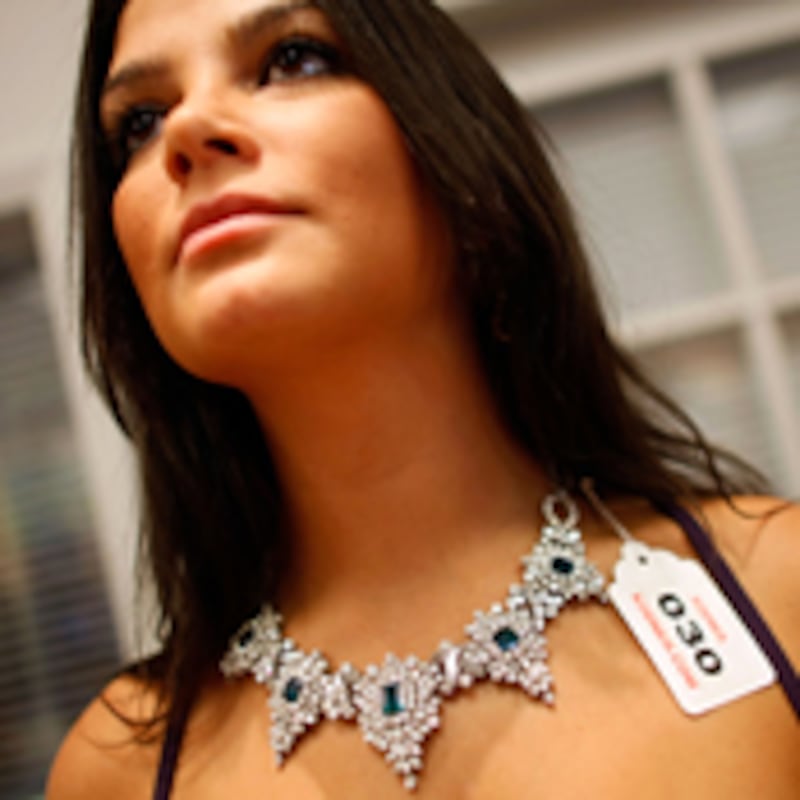
“It’s a Picasso, guys. Come on!” pleaded auctioneer Russ Kodner. He was met with only breathless silence by Wednesday evening’s packed house of bidders inside his family-run Kodner Galleries in Dania Beach, Florida. The Pablo Picasso etching had stalled at a bid of $5,400, barely above its low estimate.
Following her interview with one of the bidders, an NBC-TV news correspondent picked up a bidding placard and used it to win an antique desk.
Not that there wasn’t interest in the Picasso artwork—or the 75 other auction items being touted as from the estates of five different cash-strapped South Floridians wiped out by Bernie Madoff’s Ponzi scheme. But the crowd here was bargain-hunting, egged on by the gallery’s admission that several of the items’ original owners had been fully invested with Madoff, and were now struggling just to pay their bills.
With prominent ads in the antiquities trades and The Miami Herald all trumpeting a “MADOFF VICTIM AUCTION,” bidders had arrived en masse, with hundreds more joining the fray online or via phone. Some were collectors themselves, others interior decorators. More than a few were simply curious for a peek behind the manicured hedges of those fabled Palm Beach mansions, whose well-appointed living rooms, 50 miles north of Dania Beach, were now emptied out and up on the auction block. “I hate to get the PR out of people’s misfortune,” sighed Kodner auction coordinator Loyd Breen. “But these people really need the money. Are they going to get a million dollars back in this auction? No, but they’ll hopefully get enough to be OK.”
Indeed, the artwork, antique furniture, and vintage jewelry at auction here were, for the most part, not six-figure items. Most of the truly big-ticket goodies owned by the Madoff crowd have already been quietly liquidated through private connections or via larger Manhattan-based sales, such as the Picasso that fetched $14.6 million for Nine West founder Jerome Fisher at Christie’s earlier this month.
What’s left, at least at Kodner, looked more like the accumulated trappings of the arriviste, Floridians for whom mixing in Madoff’s elite circle was likely nearly as exciting as the size of his account returns. That meant lithographs—not actual original paintings—by abstract brushman Marc Chagall, as well as a sea of ornately carved 19th-century Chinese elephant ivory tusks that felt less blue-blood than nouveau riche, $20,000 price tags and all. Stuffed and mounted sharks hanging on the showroom wall did little to elevate the auction’s somewhat middle-brow credentials.
Indeed, while Kodner floor manager Shawn Leiter insisted that “We see ourselves as the Sotheby’s or Christie’s of South Florida,” there were more than a few differences from those tony Manhattan auction houses. True, some of the same nattily attired gentlemen you might spy at Christie’s were here at Kodner, but they had to jockey past shirts and sneakers-clad senior citizens chomping down on complimentary slices of pizza. And unlike at Sotheby’s, where a successful auction is often capped by popping open a bottle of Champagne, several Kodner staffers instead drew water pistols and giddily chased each other out the door.
Who was scooping up all this Madoff swag? Chris Page, a Coral Gables risk-management consultant, was bidding on behalf of several clients who preferred to remain anonymous. Several were Russian, Page revealed, but moguls or not, in the wake of the oil-market crash they were now just as focused on landing a deal as anyone else. With his cellphone pressed against one ear Page dropped out at $70,000 on the bidding for a 70-carat diamond, emerald, and platinum necklace, originally bought for $200,000. With glittering stones the size of a baby’s fist, it finally sold for $75,000 to Hollywood, Florida’s Stacey and Cristina Giulianti, who had no qualms about posing for a scrum of photographers afterward.
Beaming, Stacey Giulianti, a politically connected attorney, crowed that his purchase “was an amazing deal. To get it for 50 percent of the high estimate is unbelievable.” For her part, Stacey’s wife Cristina said she planned to wear the necklace out on the local charity-ball circuit. When asked if she found anything unseemly about profiting from someone else’s misery, she shrugged, “Things happen, people pass away.” What would she say if she happened to bump into her necklace’s previous (and still very much alive) owner at one of those black-tie philathropic affairs? “If our purchase helps a Madoff victim get some of their money back, it’s win-win for everybody,” she said.
That same spirit even spread to the local media covering the auction. Following her own interview with the Giuliantis, NBC-TV news correspondent Michelle Kosinski put down her BlackBerry and picked up a bidding placard, which she used to win an antique desk.
Post-auction, Kodner’s Shawn Leiter was a bit less glib about the circumstances that produced the evening’s sale. Having personally transported many of the items from one 20,000-square-foot Palm Beach home down to Kodner’s showroom, the human factor was impossible for him to ignore.
“It couldn’t have been easy for the lady who used to wear that necklace to give it up,” he said of the Giuliantis’ booty. Still, he admitted he’d been enticed by a bargain himself: At an earlier Kodner auction he’d snagged a set of Hermès china for his own kitchen. Originally retailing for $2,000, he won it for $500. A former weightlifter, Leiter joked that his social circle didn’t always expect to dine with fancy flatware. “When I’m eating breakfast and I look down at my cereal bowl and see the Hermès logo, sometime I feel a little ridiculous.” But at those moments he simply recalls every auctioneer’s credo: “It’s only money.”
Brett Sokol is arts editor at Miami Beach’s Ocean Drive magazine. His writing has also appeared in The New York Times, New York magazine, and Slate.





